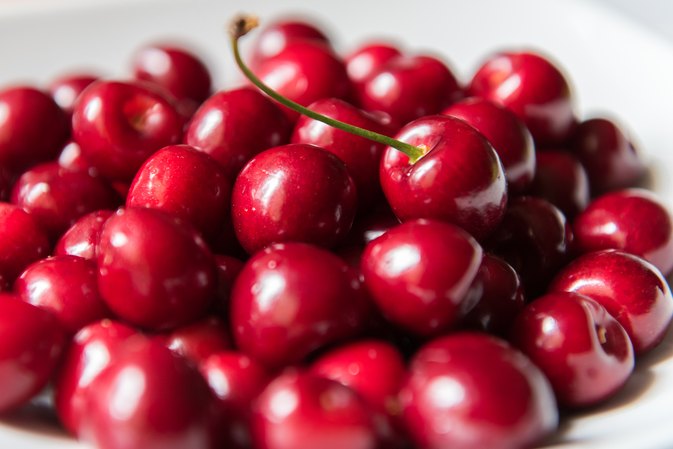Cherry Fruit Tree
Cherry Fruit Tree
The English word cherry derives from Old Northern French or Norman cherise from the Latin cerasum,[1] referring to an ancient Greek region, Kerasous (Κερασοῦς) near Giresun, Turkey, from which cherries were first thought to be exported to Europe.[2] The indigenous range of the sweet cherry extends through most of Europe, western Asia, and parts of northern Africa, and the fruit has been consumed throughout its range since prehistoric times. A cultivated cherry is recorded as having been brought to Rome by Lucius Licinius Lucullus from northeastern Anatolia, also known as the Pontus region, in 72 BC.[3] Cherries were introduced into England at Teynham, near Sittingbourne in Kent, by order of Henry VIII, who had tasted them in Flanders.[4][5][6] Cherries arrived in North America early in the settlement of Brooklyn, New York (then called "New Netherland") when the region was under Dutch sovereignty. Trades people leased or purchased land to plant orchards and produce gardens, "Certificate of Corielis van Tienlioven that he had found 12 apple, 40 peach, 73 cherry trees, 26 sage plants
Wonderfully delicious, cherry fruit is packed with full of health-benefiting nutrients and unique antioxidants. Cherries are native to Eastern Europe and Asia Minor regions. Botanically, the fruit is a “drupe” (stone fruit), belonging to the large Rosaceae family of small tree fruits in the genus, Prunus. Some of the common “drupe” family fruits are plums, peaches, apricots, etc. Although several species of cherries exist, two popular cultivars are wild or sweet cherry and sour or tart cherry. While sweet cherries belong to the species of Prunus avium, tart variety belongs to that of Prunus cerasus.
The West Indian cherry, known as acerola (Malpighia emarginata), is native to West Indian islands and grown in Mexico, and Texas regions in North America. Acerola belongs to the tropical fruit-bearing shrubs in the family Malpighiaceae and contains 2-3 tiny seeds. Acerola composes exceptionally high levels of vitamin-C and vitamin-A than North American and European cherries.
Cherry fruit nutrition featured by very low-calorific value and negligible fats. Nonetheless, cherries are a rich source of phytonutrients, vitamins, and minerals. Both sweet, as well as tart cherries, are packed with numerous health benefiting compounds that are essential for wellness.
Cherries are pigment rich fruits. These pigments, in fact, are polyphenolic flavonoid compounds known as anthocyanin glycosides. Anthocyanins are red, purple or blue pigments found in many fruits and vegetables, especially concentrated in their skin, known to have powerful antioxidant properties.
Scientific studies have shown that anthocyanins in the cherries are found to act like anti-inflammatory drugs by blocking the actions of enzymes cyclooxygenase-1 and 2. Thus, consumption of cherries may offer potential health effects against chronic painful episodes such as gout arthritis, fibromyalgia (painful muscle condition) and sports injuries.
Research studies also suggest that antioxidant compounds in tart cherries can help the human body fight against cancers, aging and neurological diseases, and pre-diabetes condition. Cherries compose of melatonin antioxidant. Melatonin can cross the blood-brain barrier easily and has soothing effects on the brain neurons, calming down nervous system irritability. It, thus, can help relieve neurosis, insomnia and headaches.
Further, they are also a small source of zinc, iron, potassium, and manganese; and a good source of copper. Potassium is a beneficial electrolyte which is an important component of cell and body fluids that regulate heart rate and blood pressure.


/https%3A%2F%2Fblueprint-api-production.s3.amazonaws.com%2Fuploads%2Fcard%2Fimage%2F829574%2Ffb2c6221-a4cd-4ec2-8537-63afc900a779.jpg)